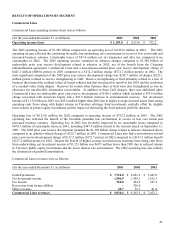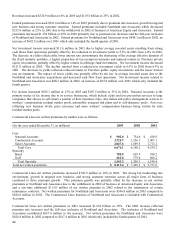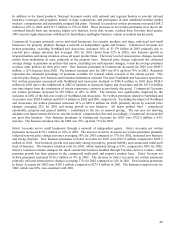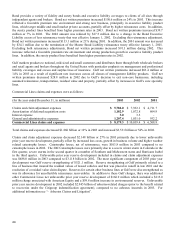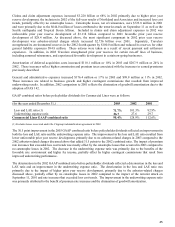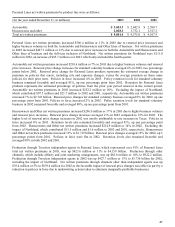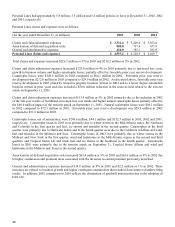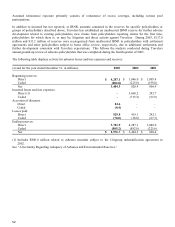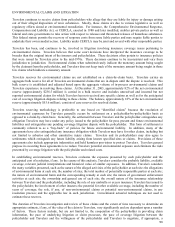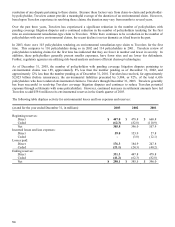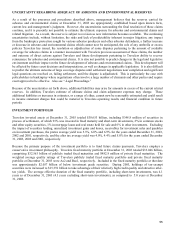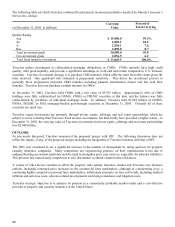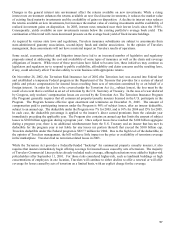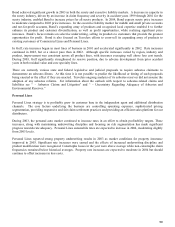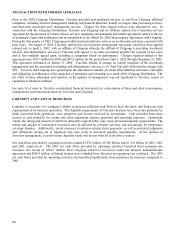Travelers 2003 Annual Report Download - page 53
Download and view the complete annual report
Please find page 53 of the 2003 Travelers annual report below. You can navigate through the pages in the report by either clicking on the pages listed below, or by using the keyword search tool below to find specific information within the annual report.
51
Travelers also compares its historical direct and net loss and expense paid experience, year-by-year, to assess any
emerging trends, fluctuations or characteristics suggested by the aggregate paid activity. As anticipated, losses paid
have increased in 2003 compared to prior years. There has been acceleration in the amount of payments, including
those from prior settlements of coverage disputes entered into between Travelers and certain of its policyholders.
Approximately 57% in 2003 and 54% in 2002 of total paid losses relate to policyholders with whom Travelers
previously entered into settlement agreements that limit Travelers liability. Net asbestos losses paid were $451.8
million for 2003 compared to $361.1 million for 2002, reflective of the items previously described.
At December 31, 2003, asbestos reserves were $2.977 billion compared to $3.404 billion as of December 31, 2002.
The decrease is reflective of the $451.8 million of payments made during the course of 2003, partly offset by accretion
of discounts of $24.2 million on reserves for certain policyholders with structured agreements. Other than accretion of
discounts, there were no additions to asbestos reserves in 2003 compared to an addition of $2.945 billion in 2002.
Travelers categorizes its asbestos reserves as follows:
Number of Asbestos
(
at and for the
y
ear ended December 31, $ in millions
)
Polic
y
holders Total Paid
(
1
)
Reserves
(
2
)
2003 2002 2003 2002 2003 2002
Polic
y
holders with settlement a
g
reements 23 2 $ 257.0 $ 196.1 $ 825.9 $ 942.1
Other
p
olic
y
holders with active claims:
Home office review 312 26 172.3 143.6 668.3 809.4
Field office review 880 80 7.6 4.9 102.4 110.0
Assumed reinsurance 14.9 16.5 229.9 242.8
Unallocated IBNR 1,150.2 1,300.0
Total 1,215
1,09 $ 451.8 $ 361.1 $ $
(1) Net of reinsurance recoveries.
(2) Net of reinsurance recoverable.
Policyholders with settlement agreements include structured agreements, coverage in place arrangements and
Wellington accounts. Reserves are based on the expected payout for each policyholder under the applicable
agreement. Structured agreements are arrangements under which policyholders and/or plaintiffs agree to fixed
financial amounts to be paid at scheduled times. Structured agreements include Travelers obligations related to PPG
Industries, Inc. (PPG). In May 2002, Travelers agreed with approximately three dozen other insurers and PPG on key
terms to settle asbestos-related coverage litigation under insurance policies issued to PPG. While there remain a
number of contingencies, including the final execution of documents, court approval over possible opposition and
possible appeal, Travelers believes that the completion of the settlement pursuant to the terms announced in May 2002
is likely. Travelers single payment contribution to the proposed settlement is approximately $388.8 million after
reinsurance. Coverage in place arrangements represent agreements with major policyholders on specified amounts of
coverage to be provided. Payment obligations may be subject to annual maximums and are only made when valid
claims are presented. Wellington accounts refer to the 35 defendants that are parties to a 1985 agreement settling
certain disputes concerning insurance coverage for their asbestos claims. Many of the aspects of the Wellington
agreement are similar to those of coverage in place arrangements in which the parties have agreed on specific amounts
of coverage and the terms under which the coverage can be accessed. During the course of 2003, Travelers made final
payments to three policyholders with settlement agreements. No new policyholders were added to this category during
2003.
Other policyholders with active claims are identified as home office review or field office review policyholders.
Policyholders are identified for home office review based upon, among other factors: aggregate payments in excess of
a specified threshold (currently $100,000), perceived level of exposure, number of reported claims,
products/completed operations and potential “non-product” exposures, size of policyholder and geographic distribution
of products or services sold by the policyholder. During 2003, an additional 48 policyholders, previously part of the
field office review, were included in the home office review. Paid losses for policyholders in the home office review
category increased by $28.7 million during the year, due to an acceleration in expected payments coupled with the
inclusion of the additional policyholders in this category. Accounts under field office review increased by 73
policyholders from 2002, as additional peripheral defendants continue to be named in suits.


